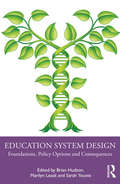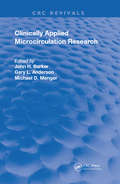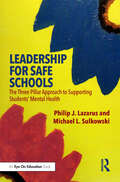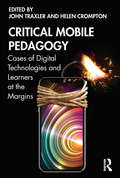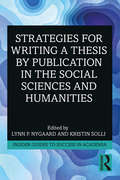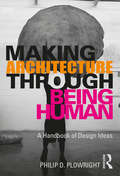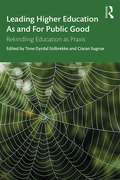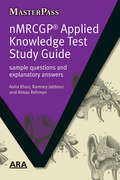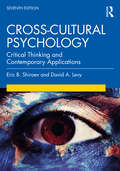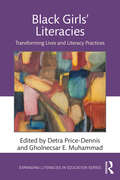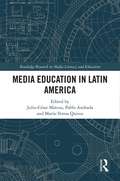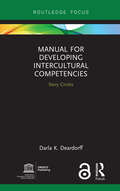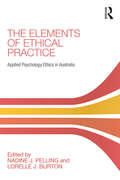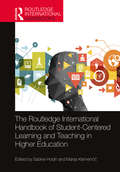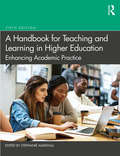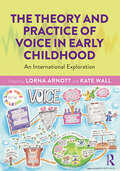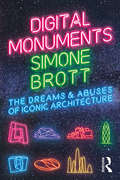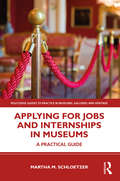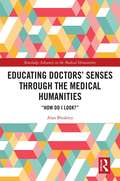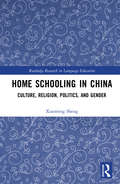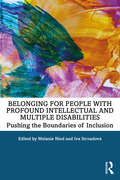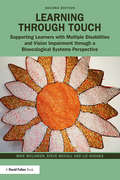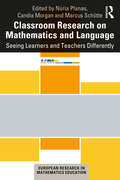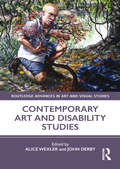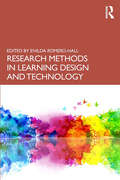- Table View
- List View
Education System Design: Foundations, Policy Options and Consequences
by Brian Hudson Marilyn Leask Sarah YounieThis book highlights decisions governments have to make about their public education systems, the options they have before them and the consequences of their decisions. As well as covering issues such as values, curriculum, teacher training, structures and so on, the book addresses education planning for epidemics, pandemics and disasters. Education systems provide the foundations for the future wellbeing of every society, yet existing systems are a point of global concern. Education System Design is a response to debates in developing and developed countries about the characteristics of a high-quality national education service. It questions what makes a successful system of education. With chapters that draw on experience in education systems around the world, each one considers an element of a national education service and its role in providing a coherent and connected set of structures to ensure good education for all members of society. Key topics include: Existing education systems and what a future system might look like Inclusion and social justice Leadership and teacher education Policy options, and the consequences of policy changes This book suggests an education system be viewed as an ecosystem with interdependencies between many different components needing to be considered when change is contemplated. It is a vital book for any stakeholders in educational systems including students, teachers and senior leaders. It would be particularly useful to policy makers and those implementing policy changes.
Clinically Applied Microcirculation Research (Routledge Revivals)
by John H. Barker Gary L. Anderson Michael D. MengerFirst published in 1995: Clinically Applied Microcirculation Research combines state-of-the-art microcirculation technology with present and potential applications in clinical medicine. This comprehensive guide unites the expertise of clinicians and basic researchers from around the world. Many of the chapters are authored by scientist/physician teams. The book provides a broad overview of how microcirculation is involved in clinical research. This is also a valuable reference source for both the history of and latest developments in microcirculation research.
Leadership for Safe Schools: The Three Pillar Approach to Supporting Students’ Mental Health
by Philip J. Lazarus Michael L. SulkowskiLeadership for Safe Schools is every school and district leader’s guide to developing practical policies and carefully designed action plans to ensure that K–12 students are physically and psychologically safe, secure, and supported. With today’s students experiencing soaring rates of depression, anxiety, trauma, loneliness, and suicidality—in addition to the effects of the COVID-19 pandemic and the normalization of school shootings—school personnel desperately need multifaceted approaches that decrease violence, facilitate social connectedness, and promote emotional well-being. This book’s proactive, preventive, and responsive Three Pillar Model offers a coherent framework for creating safe and supportive schools and fostering student mental health. Each chapter guides school leaders and administrators to implement evidence-based interventions and strategies, including: strategies for school safety, threat assessment, suicide prevention, and anti-violence efforts easy-to-apply improvements to school climate and culture social supports for diverse students, including the marginalized, victimized, and at-risk effective partnerships with families, communities, and other spheres of influence principles from positive psychology and social-emotional learning research-based strategies for trauma-informed care and crisis response Whether you are a principal or superintendent; a school psychologist, counselor, or social worker; or a school resource officer, nurse, or proactive teacher, this book will be your all-in-one inspiration for fostering resilient learning environments and implementing multi-component prevention and intervention strategies to support students’ mental health.
Critical Mobile Pedagogy: Cases of Digital Technologies and Learners at the Margins
by John Traxler Helen CromptonCritical Mobile Pedagogy is an exploration of mobile technologies for designing and delivering equitable and empowering education around the globe. Synthesizing a diverse range of projects and conceptual frameworks, this case-based collection addresses the ambitions, assumptions, and impacts of interventions in under-researched, often disadvantaged communities. The editors and authors provide a nuanced and culturally responsive approach to showcasing: indigenous, nomadic, refugee, rural, and other marginalized communities emerging pedagogies such as curation, open resources, massive open online courses (MOOCs), and self-directed learning contextual factors, including pedagogy, ethics, scaling, research methodology and culture, and consequences of innocuous or harmful implementation and deployment the nature of participation by global capital, multinationals, education systems, international agencies, national governments, and telecoms companies. Scholars, academics, policymakers, and program managers are increasingly using mobile technologies to support disadvantaged or disempowered communities in learning more effectively and appropriately. This book’s diverse research precedents will help these and other stakeholders meet the challenges and opportunities of our complex, increasingly connected world and work with greater cultural and ethical sensitivity at the intersection of education, research, and technology.
Strategies for Writing a Thesis by Publication in the Social Sciences and Humanities (Insider Guides to Success in Academia)
by Lynn P. Nygaard Kristin SolliResponding to the growing popularity of the thesis by publication within doctoral education, this book offers practical advice and critical discussion of some of the central choices and challenges that PhD students considering dissertation options face. Drawing on current research and informed by extensive experience of working with and running workshops for PhD candidates who write article-based dissertations, this book gives readers an idea of what writing a thesis by publication entails – what its purpose is, what the various expectations might be for this emerging genre, and what the challenges might be in writing one. Particular emphasis is put on how to put the individual articles together to create a coherent thesis that clarifies the student’s individual original contribution. Written primarily for students, Strategies for Writing a Thesis by Publication in the Social Sciences and Humanities covers key topics such as: how the genre has developed, with an emphasis on the role of the narrative (introductory text) that accompanies the articles typical rhetorical challenges that writers of such dissertations face strategies for handling the writing process specific challenges of demonstrating doctorateness in the thesis by publication and strategies for addressing them institutional variations that the thesis writer should seek clarification on as early as possible structural elements of the narrative and their main functions the range of choices that can be made throughout the doctoral journey and thesis writing. This book is a must-read for PhD candidates and supervisors new to the genre, as well as those involved in directing PhD programmes who are interested in the pedagogical implications of the move towards article-based dissertations.
Making Architecture Through Being Human: A Handbook of Design Ideas
by Philip D. PlowrightArchitecture can seem complicated, mysterious or even ill-defined, especially to a student being introduced to architectural ideas for the first time. One way to approach architecture is simply as the design of human environments. When we consider architecture in this way, there is a good place to start – ourselves. Our engagement in our environment has shaped the way we think which we, in turn, use to then shape that environment. It is from this foundation that we produce meaning, make sense of our surroundings, structure relationships and even frame more complex and abstract ideas. This is the start of architectural design. Making Architecture Through Being Human is a reference book that presents 51 concepts, notions, ideas and actions that are fundamental to human thinking and how we interpret the environment around us. The book focuses on the application of these ideas by architectural designers to produce meaningful spaces that make sense to people. Each idea is isolated for clarity in the manner of a dictionary with short and concise definitions, examples and illustrations. They are organized in five sections of increasing complexity or changing focus. While many of the entries might be familiar to the reader, they are presented here as instances of a larger system of human thinking rather than simply graphic or formal principles. The cognitive approach to these design ideas allows a designer to understand the greater context and application when aligned with their own purpose or intentions.
Leading Higher Education As and For Public Good: Rekindling Education as Praxis
by Tone Drydal Solbrekke Ciaran SugrueLeading Higher Education As and For Public Good asserts that the purpose of higher education is twofold: for public good and as public good. Acknowledging that the notion of public good increasingly cannot be taken for granted, the book argues that leading, teaching and learning must be directly connected to its pursuit. It avers and demonstrates how this may be accomplished, articulating specific approaches and dispositions that require cultivation within university communities. This volume argues that leading higher education occurs within competing and sometimes conflicting webs of commitments, necessitating a capacity to negotiate legitimate compromises. Its empirical chapters expand on this, providing examples of academic developers who use deliberate communication as a method in cultivating leading and teaching praxis. What emerges is the potential of deliberative leadership to be transformative in building sustainable leadership in higher education, while simultaneously renewing commitments to education and contributing to public good. Leading Higher Education As and For Public Good is essential reading for policy-makers, university leaders and administrators, academics, students and all those interested in building a sustainable future for higher education that also contributes to public good.
NMRCGP Applied Knowledge Test Study Guide: Sample Questions and Explanatory Answers
by Aalia Khan Ramsey Jabbour Almas RehmanAs three young, dynamic GPs working in London we realised that there was a dearth of well written up-to-date MCQ revision guides with satisfactory explanations. Since we all achieved distinctions in the MRCGP exam we believed we could incorporate our revision notes on hot topics to develop a high-quality contemporary MCQ resource...This comprehensive revision aid covers the entire nMRCGP syllabus over four exam papers. It's the most up-to-date guide available for the new exam and, alongside its online resources, provides a wide-ranging tool for candidates. It's easy to read and comprehend, and exam topics are grouped in the index to make for easy reference and further study.
Cross-Cultural Psychology: Critical Thinking and Contemporary Applications, Seventh Edition (Mysearchlab Series 15% Off Ser.)
by Eric B. Shiraev David A. LevyWritten in a conversational style that transforms complex ideas into accessible ones, this international best-selling textbook provides an interdisciplinary review of the theories and research in cross‐cultural psychology. The text’s unique critical thinking framework, including Critical Thinking boxes, helps students develop analytical skills. Exercises interspersed throughout promote active learning and encourage class discussion. Case in Point sections review controversial issues and opinions about behavior in different cultural contexts. Cross‐Cultural Sensitivity boxes underscore the importance of empathy in communication. Numerous applications prepare students for working in various multicultural contexts such as teaching, counseling, health care, and social work. New to the 7th Edition: over 190 recent references, particularly on studies of non-Western regions such as the Middle East, Africa, Asia, and Latin America, as well as the United States and Europe. broader discussion of gender roles and health behaviors across cultures. new discussions related to the psychological fallout of both globalization and anti-globalization tendencies. greater attention shifted from general psychological theories to specific challenges of cross-cultural psychology. new or revised chapter openings that draw upon current events. more examples related to the experiences of international students in the United States and indigenous people. updated figures, tables, and graphs that are also available for download for instructors to utilize in their online teaching. new research on global trends, nationalism, gender, race, religious beliefs, parenting styles, sexual orientation, ethnic identity and stereotypes, immigration, intelligence, substance abuse, states of consciousness, DSM-5, cultural customs, evolutionary psychology, treatment of psychological disorders, and acculturation. online resources for instructors and students. The dynamic author team brings a diverse set of experiences in writing this text that provides cross-cultural perspectives on topics such as sensation, perception, consciousness, intelligence, human development, emotion, motivation, social perception, personality, psychological disorders, and various applied topics.
Black Girls' Literacies: Transforming Lives and Literacy Practices (Expanding Literacies in Education)
by Detra Price-Dennis; Gholnecsar E. MuhammadBringing together the voices of leading and emerging scholars, this volume highlights the many facets of Black girls’ literacies. As a comprehensive survey of the research, theories, and practices that highlight the literacies of Black girls and women in diverse spaces, the text addresses how sustaining and advancing their literacy achievement in and outside the classroom traverses the multiple dimensions of writing, comprehending literature, digital media, and community engagement. The Black Girls’ Literacies Framework lays a foundation for the understanding of Black girl epistemologies as multi-layered, nuanced, and complex. The authors in this volume draw on their collective yet individual experiences as Black women scholars and teacher educators to share ways to transform the identity development of Black girls within and beyond official school contexts. Addressing historical and contemporary issues within the broader context of inclusive education, chapters highlight empowering pedagogies and practices. In between chapters, the book features four "Kitchen Table Talk" conversations among contributors and leading Black women scholars, representing the rich history of spaces where Black women come together to share experiences and assert their voices. A crucial resource for educators, researchers, professors, and graduate students in language and literacy education, this book offers readers a fuller vision of the roles of literacy and English educators in the work to undo educational wrongs against Black girls and women and to create inclusive spaces that acknowledge the legitimacy and value of Black girls’ literacies.
Media Education in Latin America (Routledge Research in Media Literacy and Education)
by Julio-César Mateus Pablo Andrada María-Teresa QuirozThis book offers a systematic study of media education in Latin America. As spending on technological infrastructure in the region increases exponentially for educational purposes, and with national curriculums beginning to implement media related skills, this book makes a timely contribution to new debates surrounding the significance of media literacy as a citizen’s right. Taking both a topical and country-based approach, authors from across Latin America present a comprehensive perspective of the region and address issues such as the political and social contexts in which media education is based, the current state of educational policies with respect to media, organizations and experiences that promote media education.
Manual for Developing Intercultural Competencies: Story Circles (Routledge Focus on Environment and Sustainability)
by Darla K. DeardorffThis book presents a structured yet flexible methodology for developing intercultural competence in a variety of contexts, both formal and informal. Piloted around the world by UNESCO, this methodology has proven to be effective in a range of different contexts and focused on a variety of different issues. It, therefore can be considered an important resource for anyone concerned with effectively managing the growing cultural diversity within our societies to ensure inclusive and sustainable development. Intercultural competence refers to the skills, attitudes, and behaviours needed to improve interactions across difference, whether within a society (differences due to age, gender, religion, socio-economic status, political affiliation, ethnicity, and so on) or across borders. The book serves as a tool to develop those competences, presenting an innovative adaptation of what could be considered an ancient tradition of storytelling found in many cultures. Through engaging in the methodology, participants develop key elements of intercultural competence, including greater self-awareness, openness, respect, reflexivity, empathy, increased awareness of others, and in the end, greater cultural humility. This book will be of great interest to intercultural trainers, policy makers, development practitioners, educators, community organizers, civil society leaders, university lecturers and students – all who are interested in developing intercultural competence as a means to understand and appreciate difference, develop relationships with those across difference, engage in intercultural dialogue, and bridge societal divides. The Open Access version of this book, available at https://www.taylorfrancis.com/books/9780429244612, has been made available under a Creative Commons Attribution-Non Commercial-No Derivatives 4.0 license.
The Elements of Ethical Practice: Applied Psychology Ethics in Australia
by Nadine Pelling Lorelle BurtonThe Elements of Ethical Dilemmas: Applied Psychology Ethics in Australia is a comprehensive and applied guide to practising psychology in an ethical and professional manner. This book is designed to assist applicants for general registration as a psychologist successfully navigate one of the eight core competencies for general registration set by the Psychology Board of Australia; specifically ethical, legal, and professional matters. The exploration of ethical dilemmas is a core task for the 4+2 pathway to general registration, while related ethical applications require exploration in the 5+1 and higher education pathways to registration as well. This book will teach readers how to identify, explore, and choose the appropriate professional course of action when confronted by ethical dilemmas in practice. The chapters include personal reflections from expert contributors relating to each of the ethical dilemmas, expertly highlighting clients’ and stakeholders’ circumstances, ethical codes and guidelines, scholarship and research, as well as other key elements in the ethical decision-making process. Especially relevant to those applying to become a registered psychologist in Australia, this book offers invaluable guidance on responding to ethical dilemmas as required by the Psychology Board of Australia in various pathways to general registration.
The Routledge International Handbook of Student-Centered Learning and Teaching in Higher Education (Routledge International Handbooks of Education)
by Sabine Hoidn Manja KlemenčičThe movement away from teacher-centered toward student-centered learning and teaching (SCLT) in higher education has intensified in recent decades. Yet in spite of its widespread use in literature and policy documents, SCLT remains somewhat poorly defined, under-researched and often misinterpreted. Against this backdrop, The Routledge International Handbook of Student-Centered Learning and Teaching in Higher Education offers an original, comprehensive and up-to-date overview of the fundamentals of SCLT and its discussion and applications in policy and practice. Bringing together 71 scholars from around the world, the volume offers a most comprehensive and up-to-date overview of the fundamentals of SCLT and its applications in policy and practice; provides beacons of good practice that display how instructional expertise manifests itself in the quality of classroom learning and teaching and in the institutional environment; and critically discusses challenges, new directions and developments in pedagogy, course and study program design, classroom practice, assessment and institutional policy. An essential resource, this book uniquely offers researchers, educators and students in higher education new insights into the roots, latest thinking, practices and evidence surrounding SCLT in higher education.
A Handbook for Teaching and Learning in Higher Education: Enhancing Academic Practice
by Stephanie MarshallFocused on developing professional academic skills for supporting and supervising student learning and effective teaching, the fifth edition of A Handbook for Teaching and Learning in Higher Education recognises the complex demands of teaching, research, scholarship and academic management in higher education institutions. Fully updated to reflect changes in practice and policy, this new edition has been written to enhance excellence in teaching and learning design and support all involved in facilitating a world-class inclusive education. Offering plentiful and rich practical advice, this rigorous and sound introduction to the basics of teaching and learning in higher education draws together a large number of expert authors and a range of global case studies. A definitive guide for anyone working in higher education, this edition: Offers new chapters covering an inclusive curriculum, the importance of student well-being and the scholarship of teaching and learning Considers the impact of technological changes on policy and practice Discusses the use of digital learning environments Explores how best to engage students in their disciplines and embed skills for employability The ultimate guide to support all those involved in providing student learning of the highest quality, A Handbook for Teaching and Learning in Higher Education is essential reading for all new lecturers. It will be particularly useful for anyone taking an accredited course in teaching and learning in higher education, as well as more experienced lecturers who wish to improve their teaching practice.
The Theory and Practice of Voice in Early Childhood: An International Exploration
by Lorna Arnott Kate WallSeeing young children as competent and capable social actors, The Theory and Practice of Voice in Early Childhood looks at how we can better understand young children’s perspectives. Drawing on the ‘Look Who’s Talking’ project, it focuses on the eight talking point posters: voice, democracy, culture, listen with purpose, space and place, skills and tools, enable and build capacity to help readers critically reflect on what voice means to them and for the children with whom they work. Combining the work of scholars and academics with front line workers and practitioners, each section groups two of the posters and provides an overview of the key theory followed by international case studies to illustrate how this thinking might be translated into practice. The book looks at all aspects of children’s voice and how to ensure that all children, including those traditionally viewed as too young, with special needs or too disengaged, have a voice. Including reflections and suggesting points for exploration and dialogue between practitioners, families and children, this will be valuable reading for those who wish to make the ideological principles of children’s voice a practical reality.
Digital Monuments: The Dreams and Abuses of Iconic Architecture
by Simone BrottDigital Monuments radically explodes "iconic architecture" of the new millennium and its hijacking of the public imagination via the digital image. Hallucinatory constructions such as Rem Koolhaas’s CCTV headquarters in Beijing, Frank Gehry’s Guggenheim Museum in Bilbao and Zaha Hadid’s Performing Arts Centre in Abu Dhabi are all introduced to the world by immortal digital imagery that floods the internet—yet comes to haunt the actualised buildings. Like holograms, these "digital monuments," which violently push physics and engineering to their limits, flicker eerily between the real and the unreal—invoking fantasies of omnipotence, immortality and utopian cities. But this experience of iconic architecture as a digital dream on the ground conceals from the urban spectator the social reality of the buildings and the rigidity of their ideology. In 18 micro-essays, Digital Monuments exposes the stereotypes of iconic architecture while depicting the savagery of the industry, from the Greek and Spanish crises triggered by financialised iconic development to mass labour-deaths on construction sites in the UAE.
Applying for Jobs and Internships in Museums: A Practical Guide (Routledge Guides to Practice in Museums, Galleries and Heritage)
by Martha M. SchloetzerApplying for Jobs and Internships in Museums offers a straightforward approach to applying for positions within a museum. Martha M. Schloetzer provides practical advice about the application and interview process that will prepare emerging museum professionals as they approach the profession. From reviewing job and internship postings to developing a solid resume and writing distinctive cover letters, this guide provides practical, sound advice for museum job seekers. Schloetzer integrates the stories of successful and unsuccessful interns and job applicants throughout the book’s narrative, and recognizing the additional challenges faced by non-US nationals, the book also offers information specifically for international students seeking work experience in US museums. The insider information included in Applying for Jobs and Internships in Museums makes it a key resource for both a US and international audience interested in gaining museum experience in the US. It will be of particular interest to college-level and graduate school students, as well as recent graduates. The guide can also serve as a reference in the classroom, helping professors and instructors prepare students for the job search ahead.
Educating Doctors' Senses Through The Medical Humanities: "How Do I Look?"
by Alan BleakleyHow Do I Look? Educating Doctors’ Senses Through the Medical Humanities uses the medical diagnostic method to identify a chronic symptom in medical culture: the unintentional production of insensibility through compulsory mis-education. This book identifies the symptom and its origins and offers an intervention: deliberate and planned education of sensibility through the introduction of medical humanities to the core undergraduate medicine and surgery curriculum. To change medical culture is an enormous challenge, and this book sets out how to do this by answering the following questions: How has a compulsory mis-education for insensibility developed in medical culture and medical education? How is sensibility capital generated, who ‘owns’ it, and how is it distributed, mal-distributed and re-distributed? What is the place of resistance (or ‘dissensus’) in this process? How can the symptom of a ‘developed’ insensibility be addressed pedagogically through introduction of the medical humanities as core and integrated curriculum provision? How can both the identity constructions of doctors and doctor-patient relationships be tied up with education for sensibility? How can artists work with clinicians, through the medical humanities in medical education, to better educate sensibility? The book will be of interest to all medical educators and clinicians, including those health and social care professionals outside of medicine who work with doctors.
Home Schooling in China: Culture, Religion, Politics, and Gender (Routledge Research in Language Education)
by Xiaoming ShengHome Schooling in China seeks to provide a better understanding of the social movement of home schooling in China. In this book, the author addresses several major themes of home education, including marketization, social stratification, culture, religion, Confucianism, gender policy, gender, and home schooling. This book draws a broad attention to the in-depth information to the relationship of marketisation, social stratification, and home education in China. It offers an implication for a better understanding not only for influences of religion (e.g. Christianity) but also the effects of Confucianism on the growth of home education in China. With a strong theoretical foundation, the book comprehensively untangles the key possible factors that shape China’s social movement of home education. The book offers a background on theories and research methodology, as well as reports on empirical studies that analyse the influences of marketisation on home schooling, social stratification, and the development of home schooling. This book is ideal reading for academics, researchers, and postgraduate students in the fields of Confucianism, social class, gender, and education in China.
Belonging for People with Profound Intellectual and Multiple Disabilities: Pushing the Boundaries of Inclusion
by Melanie Nind Iva StrnadováThis book pushes the boundaries in the way we approach people with profound intellectual and multiple disabilities, and in how we work with them in education and research. While it is grounded in diverse theoretical frameworks and disciplines, the book coheres around a commitment to seeing people with profound intellectual and multiple disabilities as equal citizens who belong in our classrooms, research projects and community lives. Each section covers policy contexts, key ideas and recent research. Featuring contributions from around the world, the book incorporates established and new voices, different disciplines and experiences. Additionally, it includes pieces from family members of people with profound intellectual and multiple disabilities. Divided into three parts, the book explores three main topics: Belonging in education Belonging in research Belonging in communities Belonging for People with Profound Intellectual and Multiple Disabilities is an invaluable resource for scholars, professionals and postgraduate research students with an interest in children or adults with profound intellectual and multiple disabilities.
Learning through Touch: Supporting Learners with Multiple Disabilities and Vision Impairment through a Bioecological Systems Perspective
by Mike Mclinden Steve Mccall Liz HodgesThis fully revised and updated second edition of Learning through Touch is essential reading for practitioners who support learners with multiple disabilities and vision impairment. These learners will rely on support from their learning partners throughout their education to mediate their learning experiences. The text explores the key role that touch plays in the education of these learners and provides practical advice about how to develop the skills through touch that they will need to become ‘active agents’ in their own development. The book reflects international initiatives that seek to ensure that people with disabilities have opportunities to take meaningful control within their learning and their lives. Key features include: Chapters that support curriculum access for learners with visual impairments; Reflections on up-to-date research studies and guidance for further reading throughout, allowing for a strong conceptual foundation for practice; Portfolio activities designed to help implement effective learning opportunities within your own practice. Written to assist teachers and other professionals who support children with visual impairment and additional difficulties, this text will appeal to professionals and students alike. It is an invaluable resource for anyone looking to explore the role of touch in creating effective learning experiences.
Classroom Research on Mathematics and Language: Seeing Learners and Teachers Differently (European Research in Mathematics Education)
by Núria Planas Candia Morgan Marcus SchütteThis book offers an international perspective on the current and future state of the research, focusing, in particular, on the role and use of language in mathematics school teaching and learning. It focuses on the development of a unified view of the languages of the learners, of the teachers and of mathematics by considering the role of language in the learning, teaching and doing of mathematics in the classroom, and the current richness and plurality of language and culture. The contributions in this volume combine to show how views of language and of language research in mathematics education have changed significantly in recent decades, and how they will continue to change and become even more complex and challenging in the era of diversity. All of these contributions by leading scholars are grouped into two sections for emphasis on issues of: • Theorising the complexity of language in mathematics teaching and learning • Opening spaces of learning with mathematics classroom research on language This book will be of great interest to mathematics teachers, teacher educators, curriculum developers and mathematics education researchers who deal with the study and implementation of pedagogies of mathematics teaching and learning, specifically in regions of the world which are culturally and sociolinguistically diverse.
Contemporary Art and Disability Studies (Routledge Advances in Art and Visual Studies)
by Alice Wexler John DerbyThis book presents interdisciplinary scholarship on art and visual culture that explores disability in terms of lived experience. It will expand critical disability studies scholarship on representation and embodiment, which is theoretically rich, but lacking in attention to art. It is organized in five thematic parts: methodologies of access, agency, and ethics in cultural institutions; the politics and ethics of collaboration; embodied representations of artists with disabilities in the visual and performing arts; negotiating the outsider art label; and first-person reflections on disability and artmaking. This volume will be of interest to scholars who study disability studies, art history, art education, gender studies, museum studies, and visual culture.
Research Methods in Learning Design and Technology
by Enilda Romero-HallResearch Methods in Learning Design and Technology explores the many forms, both new and established, that research takes within the field of instructional design and technology (IDT). Chapters by experienced IDT researchers address methodologies such as meta-analysis, social media research, user experience design research, eye-tracking research, and phenomenology, situating each approach within the broader context of how IDT research has evolved and continues to evolve over time. This comprehensive, up-to-date volume familiarizes graduate students, faculty, and instructional design practitioners with the full spectrum of approaches available for investigating the new and changing educational landscapes. The book also discusses the history and prospective future of research methodologies in the IDT field.
